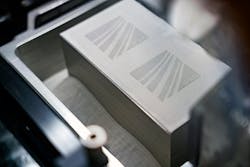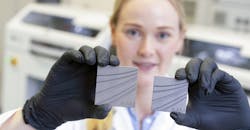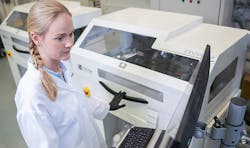R&D Partners Focus on Binders for Reactive Metal 3DP
Metal additive manufacturing specialist The ExOne Company is expanding its research to develop binders and materials with the Fraunhofer Institute for Manufacturing Technology and Advanced Materials (IFAM), following their collaboration on the CleanFuse™ metal.
CleanFuse is a clean-burning metal binder that ExOne introduced in 2019, one of a series of formulations introduced at that time for binder-jet metal 3D printing, to minimize carbon residue left behind by other binding agents during sintering.
“CleanFuse is an important advancement for the field of binder jet 3D printing,” ExOne CEO John Hartner said at that time. “In addition to enabling the future binder jet 3D printing of aluminum and titanium, CleanFuse will also be important for 3D printing some beta materials now moving through our strict qualification process, such as Inconel 718 and 625.”
Binder jetting is an additive manufacturing process that draws design data from a digital file to “inkjet print” the binder into a bed of powder particles (metal, sand, or ceramic), to create a solid part, one layer at a time.Printed metal parts must be sintered once they reach the final shape in order to fuse the particles together into a solid object.
When binders do not burn off cleanly during sintering, however, carbon residue can alter the chemistry and potentially the performance of some sensitive metals. So, 3D-printing metals with CleanFuse helps to maintain consistent part performance, including a part’s ability to be welded.
IFAM’s research center in Bremen, Germany, has long experience in additive manufacturing – especially for sinter-based processes – working with a range of ExOne printers. Recently, the Institute put into operation the X1 25Pro production-speed metal binder-jetting system for pilot and pre-series production.
Fraunhofer IFAM and ExOne have been collaborating on metal binder jetting for over 20 years, and they have worked together to refine and optimize CleanFuse, which is based on an IFAM development.“When we started developing the first binder version on the Innovent (ExOne 3DP system), we soon realized we had a major breakthrough,” recalled Frank Petzoldt, deputy director of Fraunhofer IFAM. “ExOne was immediately very enthusiastic about our development, because of its exceptional, green part strength and clean burnout at low curing temperature.
“Together with ExOne, we refined the binder, which is now CleanFuse,” Petzoldt added.
Now, IFAM and ExOne are working on a CleanFuse version for processing reactive materials, such as aluminum and titanium. “At ExOne, we truly believe in the power of collaboration – of bringing together a diversity of experts and knowledge – to solve complex problems in the best possible way,” said Rick Lucas, ExOne chief technology officer and VP, New Markets. “Fraunhofer IFAM has been a leading collaboration partner for us – helping to improve our understanding of binders, different types of powders, and how they work together through the entire process chain from printing to final sintering to deliver a quality part.”


